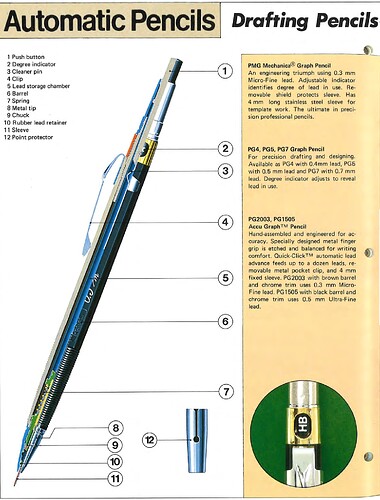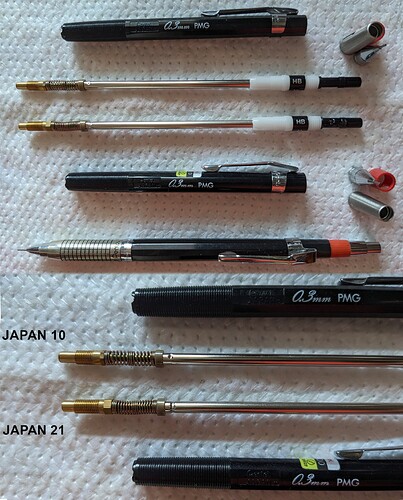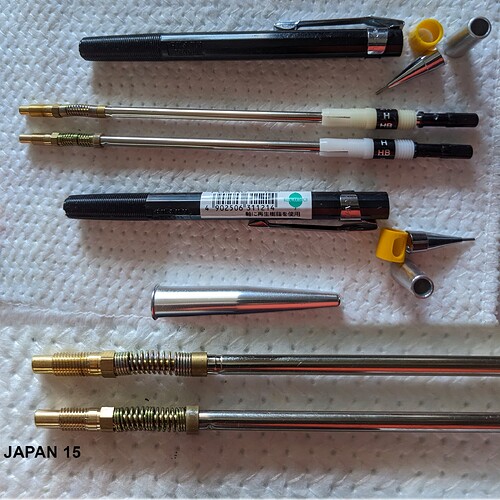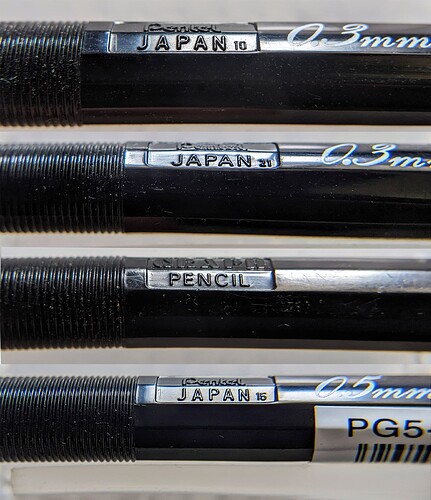There’s a reason why Pentel has over 125 post tags on Knockology. It’s probably the most popular mechanical pencil maker on the planet. One can get lost within this brand alone, given the breadth of what has been released over the years since the 1960’s.
@nimrodd did a phenomenal job in creating an interactive compendium for Pentel pencil models, HERE. And of course, major thanks to @Thomas for his involvement and hosting!
I’m by no means a prolific Pentel mechanical pencil collector, especially when looking at some of the veteran members here with such storied collections. I’m just happy to dabble… and occasionally turn up something interesting to share. And while Jimmy’s book does a great coverage of all the Pentel models, I thought I’d share a little more on what I’ve come across in my narrow exploration.
PG = Pentel Graph series launched in the 1970s. The lower cost plastic bodied line featured PG2, PMG, PG4, PG5, and PG7. Why “PMG” instead of PG3? The reason was to differentiate from the other models, as this one had a special feature–a protective steel collar to guard the tip. “M” is for “Mechanica,” as a nod to the 1968 released Pentel Mechnica. I think the reason why that word was chosen is due to the mechanical control of the extendable and retractable protective sleeve. And while the PMG doesn’t have that mechanism, it still enjoys the same protection. Pentel smartly designed it such that the sleeve detaches from the front and docks on the rear for safe keeping. I left mine docked here, but you can see it removed in this photo from Nimrodd’s catalog: https://pentelidbook.nyc3.cdn.digitaloceanspaces.com/PMG.jpg
I don’t possess the full PG line, having only the PMG and PG5, as well as the Mechanica. You can see details of each model on Nimrodd’s fantastic online Pentel Identification Book, 1970s section.
There were 3 different releases for the PMG. Series PHOTO. I have two of them, from the 3rd batch. And even with those, there are some very minor differences (internally). One has a mold code of 10, and the other is 21.
I had wanted to get the first series release of the PMG, but it’s too hard to find now and seller asking prices are too high for what I consider reasonable. I bought both of mine off of Yahoo Auctions Japan. The first was a good condition user (bought about 6 years ago), while the second is a near NOS condition example with sticker that I picked up recently.
I’d bought a PG5 a good 6 or 7 years ago. I prefer it to the P20x series as I just like the grip design and find it more visually appealing. They’re so cheap now on Amazon USA, that I grabbed one to add enough in my cart for free shipping. It was interesting to compare releases, as they have some differences (but operation is identical). The old one doesn’t have a mold code, while the newer one does. You can see the white screw thread coupler has yellowed a little on the old one.
In case anyone is curious, that long metal cone you see was something I picked up from an art supply store. It works as an excellent guard for the front half. It has a gap running up about 1/3rd of the way on one side, as a control for flexing.
Mold codes and other embossed lettering:
Since Pentel made a limited edition release of the P20x series, I’m hoping one day they do the same for the PG series. Since the PG5 is still in production, it wouldn’t be hard to make the PG2, PMG, and PG7 variants.





